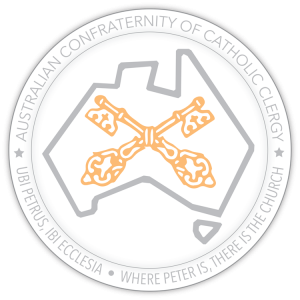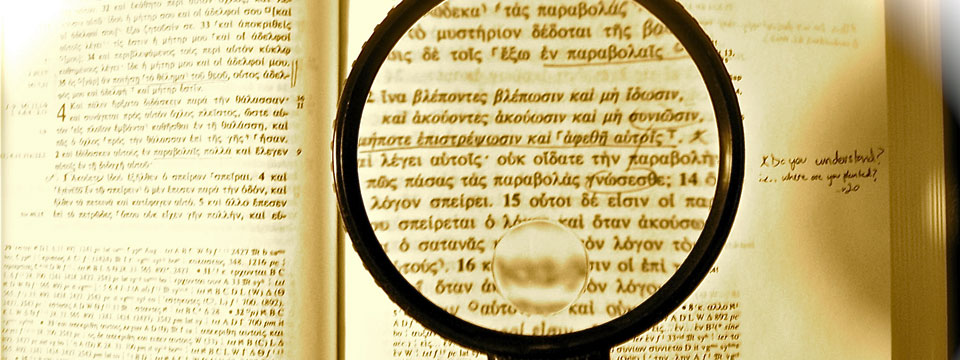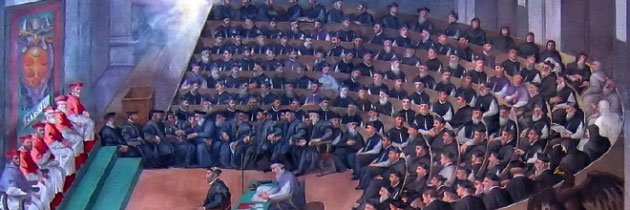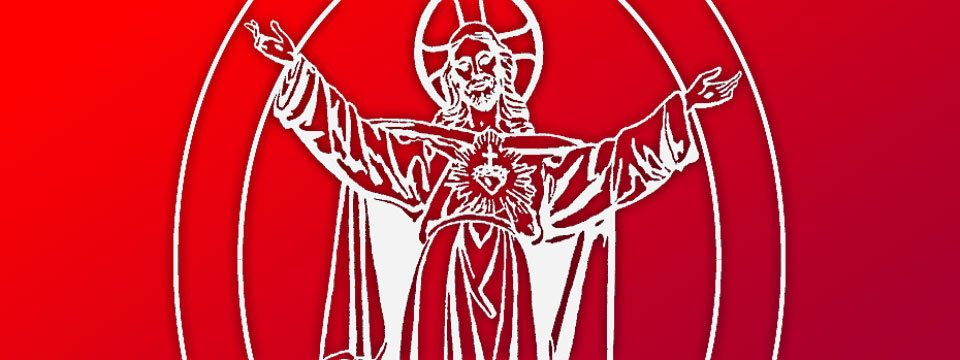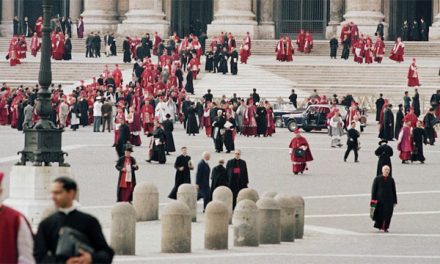The title of this presentation has already created some surprise, so I have to clarify from the start that, in actual fact, it will not deal with the Roman Inquisition as a historical institution, but rather with the right method of [theological] inquisition; that is, as the search for truth – which, in turn, becomes fundamental for the work of the Congregation for the Doctrine of the Faith (CDF) today. This surprise, however, itself offers a practical demonstration of the need for proper hermeneutics: in the sense of acknowledging the existence of one’s, more or less useful, prejudices and expectations.
Identifying a hermeneutic
All attempts at promoting and defending the Catholic Faith presuppose an understanding of the faith in a way coherent with both the faith itself and human reason or nature. On the one hand, the debate about hermeneutical questions has been going on for many decades, but certainly it is to the great merit of Benedict XVI that it has been brought back to the forefront of ecclesial and theological discussions today. I dare say it is a good thing that such discussions should continue not only in the “celestial” blogosphere, but also within academic theology, otherwise a suspicion grows amongst those who prefer to avoid it, that such a discussion is banned.
How do we “do theology”?
In my view, the debate about proper methodology and a hermeneutic of Catholic theology is far from over. Our contemporary situation, both in the Church at large and in theology in general seems, rather, to have reached the limits of mutual understanding. Large groups within the Church (and its theological elite) seem to disagree not only about certain theological matters but also about how one should go about understanding – how to “do theology”. This kind of schism is more profound, and much more complex, than the usual issue in which one party might disagree about an article of the faith or about certain principles of discipline.
A “Hermeneutic of Renewal in Continuity”
As the Holy Father pointed out in his first Christmas address, the decades after Vatican II were dominated by what he calls a hermeneutic of reform in the sense of “discontinuity” or even “rupture,”{{1}} a breaking away from considered traditional views and practices merely according to the principle: “what we did once, we shall now do differently. This will be obviously better, because we know better.”
It was little wonder, that after some time a reaction did arise against precisely such positions, for a response was indeed necessary – a response that would force a rediscovery of the treasures that have often been discarded all to easily. This response intended to follow what has become known as a “Hermeneutic of continuity” consciously opposing, and even provoking, the dominant theological establishment. It is fair to say, however, that even this reaction is itself part of a hermeneutical process, and can only be useful if it is able to follow a truly catholic hermeneutic; namely, that hermeneutic briefly alluded to in the Pope’s 2005 Christmas address – a text that I consider to be among the most significant pronouncements of Benedict, if not the most significant.
Precise formulations
We should pay attention, therefore, to the precise formulations used by the Supreme Pontiff when he spoke of the “Hermeneutic of reform… [the hermeneutic] of renewal in the continuity of the one subject-Church which the Lord has given to us”.{{2}} And when, thirteen months later, he returns to this same topic, he remains faithful to his original choice of words, when he spoke again about a “Hermeneutic of renewal in continuity” that also must be followed also in juridical practice.{{3}} These exact words are not accidental and should indeed challenge not only those to whom the Holy Father was referring – that is, the adherers of a [modernist] reform-hermeneutics -, but also to those who declare themselves to be followers of his “hermeneutic of continuity”. It is very often this latter group who seem regularly to forget that the Pope, and indeed the Council, have called for a reform, for an authentic renewal within the continuity of the One Church which however needs to be purified by authentic reform and renewal precisely because the Church always remains identical with herself.
I think it is legitimate, at this point, to name some of what I regard as the main expressions of such a “renewal in continuity”. It should be noted too that the Holy Father has contributed to most of them: the Code of Canon Law of 1983 (and its Oriental counterpart of 1990); the Catechism of the Catholic Church (1992); and the major Papal teaching documents and those of the CDF which have been promulgated since the Council. As “Papa Ratzinger” has pointed out in numerous occasions: these texts are the guidelines for a proper, legitimate, authentic and honest reading, and living of, the conciliar legacy.
Those theologians who have been impressed, either by the arguments themselves, or by the authority of the Pope, have hardly ever rejected Pope Benedict’s program of “renewal in continuity” as such. But it is true that many have either interpreted it in their own way (another hermeneutically interesting move) or they have proposed other, alternative, hermeneutics said to counterbalance that of the Pope. In this way while they have been appreciative of his particular hermeneutic, they have nevertheless considered it requiring further development and completion. In other words for some of them, the papal hermeneutic of reform in continuity is one legitimate form but only one among various others.
This position, while seemingly respectful of the Roman Pontiff, and, moreover, seemingly academically presentable, is, I will argue, actually quite untenable. To see this it will be necessary to look at the philosophical background that is, as I claim, that on which the Holy Father’s approach rests. Catholic hermeneutics as we will see must indeed include historical, philosophical and theological horizons.
Philosophical Hermeneutics and the work of Gadamer
“Philosophical Hermeneutics” as a discipline is mainly the work of Hans Georg Gadamer (1900-2002), whose foundational book entitled Wahrheit und Methode was first published in 1960. Still referring to this his first publication, many years later, Gadamer wrote:
We are standing in traditions, whether we know these traditions or not, whether we are conscious of them or are as haughty as to think we are beginning without prerequisites – that changes nothing with regard to the effect of traditions on us and on our understanding.{{4}}
Gadamer, from the beginning, developed his hermeneutical project critical of an exaggerated concept of the capacities of the [individual] human being. This concept he considered to be the result of misguided Enlightenment thought. Gadamer instead wished to identify that there was no human understanding without [historical] preconditions. The human subject never enjoys absolute neutrality vis-à-vis those realities which surround it. Understanding always happens within a “hermeneutical circle”, that consists of pre-existing concepts and traditions and previous personal experiences, both conscious and not. This circle is inescapable and necessary, and its “pre-judices” are to be viewed not as psychological problems or obstacles in the way of understanding, but as the essential and useful starting points for all human understanding. Naturally enough in the course of human understanding room is left for a necessary revision and perfection of these prejudices.
Gadamer thus came to say (provocatively since one need only think briefly about German professors and their history of scientific neutrality!):
a) “In truth, history does not belong to us, but we belong to it.”{{5}} History, as Gadamer perceives it, is not separated from us, but through tradition we are connected to the past and to whatever we try to understand.
b) “The anticipation of meaning, which guides our understanding of texts… is determined by the togetherness which connects us to tradition.”{{6}} This ‘connection’ does not refer only to the material of tradition, but it also defines the method (how we understand) and, even more profoundly, it communicates to us the very desire and possibility of understanding and gives us access to, or even belief in, meaning.
c) “Understanding is inserting yourself into the happening of tradition, in which past and present are continually mediated.”{{7}} For the individual, understanding means respecting “my (humble) place” in history and within tradition, and it requires starting from that place – anything else will only lead to confusion.
For Gadamer, the human condition is inescapably historical; therefore, the rules developed for understanding the past are valid for all forms of understanding. Attempts to deny this existential fact are, for him, destined to fail:
d) “being historical means never arriving at complete self-knowledge. All self-knowledge arises from historical preconditions.”{{8}} There is a limit to self-understanding, which needs to be respected in order to get to any form or degree of self-knowledge. This limit gives human (self-) understanding its proper form – which is essentially a Platonic concept. This idea can easily be transposed onto human knowledge of the other and of God, as both start from nothing and never come to an end, at least not in this world.
e) While Gadamer cherishes the fruitful role of (traditional) prejudices, he also insists on another prerequisite for human understanding: “Whoever wishes to understand a text, is… ready to be told something by it. Therefore, the hermeneutical mind must be open for the otherness of the text from the beginning. Such openness however does not mean objective neutrality or self-extinction, but includes a conscious owning of one’s own pre-concepts and prejudices. ”{{9}} Again, this is a hermeneutical circle: knowing myself, my preconcepts and prejudices, becomes the condition for knowing anything, and thus for developing these concepts, and subsequently, deepening my self-knowledge. Gadamer’s way of thinking can rightly be compared to a game, a play that has different players, myself included, objects and rules; but which you cannot really understand unless you are in the game, part of it.
It comes as no real surprise, then, that Gadamer’s thought did not remain uncontradicted, even though many Catholics welcomed it, though sometimes perhaps somewhat naively. It was not long before Gadamer himself was suspected as a reactionary. As Wahrheit und Methode was published in 1960, the years following were not, shall we say, a period particularly open to receive his teaching.
Gadamer’s opponents
The main opponent to the thought of Gadamer was/is Jürgen Habermas (born 1929) and his position of Ideologiekritik. His criticism of Gadamer’s positions can be summed up in the following points:{{10}}
a) “Enlightened thought” does not allow for an unbroken relationship with tradition. Numerous historians claim that we can never really overcome the deep abyss that separates us from the past. Habermas sees the crucial divide in Enlightenment, having effected a kind of “total transformation” of the human: shattering once-and-for-all its relationship of trust in history and tradition. While this assertion is not free from a certain contradiction and itself would need to be criticised, we cannot deny the phenomenal success of precisely such a standpoint, even today.
b) The second critical point Habermas raised was:
Tradition is obfuscated by open or hidden structures of domination and ideologies. This remark, while per se odious to the good traditional catholic, is regarded in a much more positive manner, when applied to theologians and who theologies that have appeared and dominated in more recent decades
c) Thirdly, according to Habermas, there are unconscious barriers of communication and understanding: consensus and assent are the consequence of pseudo-communication: Habermas may have said this in order to disprove Gadamer’s seemingly blind trust in tradition. If we apply his thought merely to the political and media “reality” of our times, I find little with which to disagree.
Habermas’ points appear to be, at least partially, legitimate criticisms. Certainly, Gadamer’s views do contain several inherent problems, of which the main one seems to be that:
d) According to Gadamer: the individual disappears into the historical process.{{11}} When we look at how he defines the relation of the individual to tradition, we have to ask: Who is the understanding subject? Is there a kind of universal tendency towards higher understanding? Under whose direction? And how do we deal with historical setbacks? It would certainly be fascinating to investigate the medieval debate about the agent intellect (and its unity – or not) from a specifically hermeneutical interest, should there be someone here looking for a topic for a PhD!
Gadamer’s responses
Gadamer himself seems to have been quite unimpressed by such criticisms. He did not see them as contradictions to his theory, but rather as useful for understanding it correctly. According to Gadamer’s famous “Replik” – or “reply” – to his critics:
Tradition is never only that which someone knows as his own origin or of what he is conscious, so that tradition can never be exhausted in an adequate historical consciousness. Changing the existing realities is no less a form of being connected to tradition than defending what exists. Tradition in itself exists only in continual becoming other.{{12}}
And really, from both philosophical, and theological, points of view it is hardly possible simply to deny Gadamer’s fundamental intuitions, which can indeed be integrated usefully into a Catholic vision.
Gadamer saw tradition as the bond between us and the past, the context in which all understanding happens. For ecclesial and Catholic hermeneutics, this is certainly quite a valid intuition, but it needs to be applied to the Church and developed according to St John’s words: “See that what you have heard from the beginning remains in you.” (1 John 2:24){{13}}
Principles to be noted
In order to do this correctly, a few principles need to be borne in mind:
a) Catholic faith requires and provides not only for a connection to the past, but for a presence: Tradition keeps the beginnings present and alive for contemporary understanding. For all historical work in theology is aimed at bringing out the truth for today. Catholic theology holds on to the concept of an unchanging core-content of the Faith, which is not opposed to a development of doctrine, but rather necessary in order to be able to speak rightly of a “development” rather than a mere “substitution”. John Henry Cardinal Newman’s contribution in this field is still enlightening. Indeed, I am sure he would agree with the following statement that:
b) Identity can be maintained only in faithfulness to those beginnings. The Apostolic Faith remains normative; the preceding Councils are normative for the following ones, which, in turn, limit and determine the meaning of the earlier ones. In the end, it is Christ himself who remains the prevailing norm, to whom we are connected by means of the tradition, which represents His own teaching and example to us in the present.
c) Recourse to the beginning confronts us with the criticism of the history of effects. We go back to the beginning through the steps of tradition, not in a kind of “jump over all things” between us and Jesus! The effects, the traces that the Gospel has left in human and Church history must not be overlooked for they have an inescapable, be it hidden, influence on our own thinking.
d) Understanding happens within a continuity that corresponds to the human being whose freedom is not constrained but rather enabled by that continuity. Such a realistic, modest and, at the same time, demanding concept of human understanding is constructive from a Catholic point of view, recognising both the capacities and the limits of the human being, and of the believer specifically. We can understand/know something about ourselves, and even about God; but in order to do so we need to follow the rules – that is, we need to respect our human nature (and reason) – as both God’s creation and one which exists in a fallen state. This is indeed the hermeneutical a priori as formulated by Catholic doctrine.
A Catechetical summation
Allow me, then, the luxury of a long, but essential quote from the Catechism of the Catholic Church (§§ 36-38) which says:
“Our holy mother, the Church, holds and teaches that God, the first principle and last end of all things, can be known with certainty from the created world by the natural light of human reason” (Vatican I, Dei Filius, cited in Vatican II, Dei Verbum). Without this capacity, man would not be able to welcome God’s revelation. Man has this capacity because he is created “in the image of God“ (Gen 1:24).
In the historical conditions in which he finds himself, however, man experiences many difficulties in coming to know God by the light of reason alone … “So it happens that men in such matters easily persuade themselves that what they would not like to be true is false or at least doubtful” (Pius XII).
This is why man stands in need of being enlightened by God’s revelation, not only about those things that exceed his understanding, but also “about those religious and moral truths which of themselves are not beyond the grasp of human reason, so that even in the present condition of the human race, they can be known by all men with ease, with firm certainty and with no admixture of error” (Pius XII).
To give only one example: The Church’s teaching on abortion is per se reasonable, accessible to non-believers, grounded in natural law; but we must not underestimate how difficult it is, in the precise variables of the modern world, to accept such a teaching without the Faith. Here too, however, Revelation cannot truly be superfluous, and thus much work needs to be done by Christians to ensure the richness of this teaching, based on the natural law, can be sufficiently discovered and appreciated.
On “hierarchies” in truths and in hermeneutics
The consequences of proper hermeneutics, however, do not touch only the Church’s working ad extra, but also apply ad intra. We need to pay attention to the rules and the contexts laid out by both of these “workings”. In this sense, I would like to speak of a “hierarchical hermeneutics”, in accordance, essentially, with what which Vatican II taught about the “Hierarchy of Truths”:
Moreover, in ecumenical dialogue, Catholic theologians standing fast by the teaching of the Church and investigating the divine mysteries with the separated brethren must proceed with love for the truth, with charity, and with humility. When comparing doctrines with one another, they should remember that in Catholic doctrine there exists a “hierarchy” of truths, since they vary in their relation to the fundamental Christian faith. Thus the way will be opened by which through fraternal rivalry all will be stirred to a deeper understanding and a clearer presentation of the unfathomable riches of Christ (Unitatis redintegratio 11).
Not only ecumenical dialogue, but all theology needs to pay attention to that systematic cohesion which exists within and between Catholic doctrine(s). The term “hierarchy of truths” has frequently been abused of late, and it certainly does not propose a distinction between more or less important truths, such as might allow us to dispose of, or glance over, some or all Catholic teachings. Instead, the notion of “Hierarchy” speaks of the logical and catechetical order demanded not only at the point of explaining the faith, but which must equally apply already in the understanding of it.
The Catholic “et – et” principle
Cardinal Leo Scheffzyk (1920-2005) has explained this Catholic way of thinking as the system of the “et – et.”{{14}} It is relatively simple then to come up with a whole list of couplets illustrating this idea:
- Word and Sacrament
- Faith and Works
- Scripture and Tradition
- Lex orandi and Lex credendi
- Nature and Grace
- Reason and Mystery
- History and Idea
- Office and Charism
- Objectivity and Subjectivity
- Universalism and Unity
- Continuity and Progress
- Tolerance and Discipline
- Community and Person
- Supernatural and Incarnation
The unity principle
The Faith can not be reduced to a single principle (such as the doctrine of justification), but rather must rest on the Creed, and thus on Trinitarian and Christological doctrine. The principle of Unity, therefore, is itself Christological: God and Man in Jesus Christ.{{15}}
According to this principle of Unity, we must :
a)Never follow the (heretical) paradigm of the ellipse or the “two columns” (Scripture-Tradition, Word-Sacrament, Clergy-Laity), as if they could be unconnected;
b) always remember that the relation between God and Man/World stands in God himself.
Conclusions
Theology as faith seeking understanding, therefore, starts from that fundamental relationship – traditionally called the Analogy of Being, Analogia entis – according to which, the dissimilarity between God and the World is greater than any similarity between them: Deus semper maior. This relationship is the basis on which rests the mystery of the Incarnation of Jesus Christ and our capacity of being connected to and knowing it – and Him.
For these reasons, theologians and preachers must realise the (wider and narrower) contexts in which they stand and “read together” the various sources and authorities of our faith, which are not all on the same level and between which we are not seeking a compromise but a harmony.
To properly understand these various sources requires:
a) discovering the concordance of the different authorities, witnesses and expressions of the Faith,
b) seeing between them a Complementarity or a mutual Correction (in the sense of avoiding misleading, unilateral exegesis) or a spelling out the Consequences.
c) In putting together our personal picture of catholic theology, we will necessarily “do theology” and thus be part of a theological school or tradition. We always have to bear in mind that on the level of theology there is no absolute normativity, but instead a relativity of theological schools. Certainty belongs to doctrine only, yet understanding the divine mysteries never comes to an end, certainly not in this world, and this infinity is not so much caused by our own sinful weaknesses as it is due to our limited, created being.
Based on these philosophical and theological foundations, for all forms of proclamation of the Gospel and teaching the Faith, we need to be aware of the inevitable laws and, consequently, the requirements of a proper, and properly Catholic, Hermeneutics:
a. Our understanding the Faith needs to take on board that it is itself only possible within the horizon of the Church. This horizon is wider than any other, but still will realise we are unable to exhaust the divine mysteries.
b. There must always be systematic respect for the Competence of the Church –according to the categories of Teaching, of the Judiciary, or of offering advice and consultation.
c. In reading texts, and in speaking or writing about theological issues, scholars should follow a strict Distinction between the obligatory Doctrine of the Church and theology. In this work the traditional degrees of certainty/ assent are still helpful, and historical precedents and examples, even analogous ones, should be studied and followed.
d. As much as this will be possible, we should seek to take into account the different theological disciplines, schools, Orders, nations, age groups which exist in the Church.
e. Both the culture and the procedural organisation of doctrinal assessment in the Church should be characterised by collegial work, consultation and decision making, aiming, if at all possible, to a consensus.
f. Of course, all procedures have to respect that hierarchical order, which comes out most clearly in our filial devotion to and reliance on the Supreme Pontiff himself, who is himself the living voice of Tradition in the Church of Christ.
Catholic theology, on all levels, from the heights of academe to first communion classes in our parishes, is in need of a renewal that respects the fundamental rules of hermeneutics in general and as they apply specifically to the Catholic faith. This will require historical, but also philosophical awareness which are indeed the pillars on which rests all theological progress and which will lead us to a fuller appreciation of the Church as the horizon in which all true understanding has it place, a horizon that is much wider than any other for “God is greater than our heart, and knoweth all things” (1John 3:20).
[[1]]Benedict XVI, Address to the Roman Curia (22 December 2005).[[1]]
[[2]]Benedict XVI, Address to the Roman Curia (22 December 2005).[[2]]
[[3]]Benedict XVI, Address to the Members of the Tribunal of the Roman Rota (27 January 2007).[[3]]
[[4]]Hans-Georg Gadamer – Carsten Dutt, Hermeneutik – Ästhetik – Praktische Philosophie: Hans-Georg Gadamer im Gespräch, Heidelberg 1995, p. 21 [trans. from German by the author].[[4]]
[[5]]Hans-Georg Gadamer, Wahrheit und Methode, Tübingen 1960, 41975, p. 281.[[5]]
[[6]]Wahrheit und Methode, p. 277.[[6]]
[[7]]Wahrheit und Methode, p. 275.[[7]]
[[8]]Wahrheit und Methode, p. 307.[[8]]
[[9]]Wahrheit und Methode, p. 273f.[[9]]
[[10]]For an overview of the discussion between Gadamer and Habermas see Jean Grondin, Einführung in die philosophische Hermeneutik, Darmstadt 22001, 178-185.[[10]]
[[11]]Cf.. Wahrheit und Methode, p. 261.[[11]]
[[12]]Cfr. Hans-Georg Gadamer, Replik zu ‘Hermeneutik und Ideologiekritik’ (1971): Wahrheit und Methode. Ergänzungen, Register (Gesammelte Werke II), 251-275, 268.[[12]]
[[13]]Still very helpful on Catholic hermeneutics and itself an interesting contribution to its history is Franz Mußner, Geschichte der Hermeneutik von Schleiermacher bis zur Gegenwart. Freiburg 21976. (HDG I,3c). Mußner, now a retired Canon of Passau Cathedral, was the Professor of New Testament at Regensburg University at the time when the then Joseph Ratzinger was the professor of dogmatic theology. Benedict XVI recently named him Apostolic Protonotary.[[13]]
[[14]]Cf. Leo Scheffczyk, Katholische Glaubenswelt. Wahrheit und Gestalt, Paderborn 32008, 37-39.[[14]]
[[15]]Cf. Scheffczyk, Katholische Glaubenswelt 39-52.[[15]]
